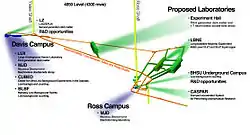LZ experiment
The LUX-Zeplin (LZ) experiment is a WIMP detector.[1] The international collaboration constructing it formed in 2012 by combining the LUX and ZEPLIN groups. It is to be located at the Sanford Underground Research Facility (SURF) in South Dakota,[2] and managed by DOE’s Lawrence Berkeley National Lab (Berkeley Lab). The LZ experiment is a next-generation dark matter direct detection experiment, an ultrasensitive detector that will use 10 metric tons of liquid xenon to hunt for signals of interactions with theorized dark matter particles called WIMPs, or weakly interacting massive particles. When completed, the experiment will be the world’s most sensitive experiment for WIMPs over a large range of WIMP masses[3] In the spring of 2015, LZ passed the ‘Critical Decision Step 1’ or CD-1 review, and became an official DOE project.[4] U.S. Department of Energy officials on Sept. 21, 2020 formally signed off on project completion for LZ; DOE’s project completion milestone is called Critical Decision 4, or CD-4.[5]
LUX-Zeplin (LZ) experiment | |
|---|---|
experiment | |
 | |
| Country | |
| State | |
| Website | The LZ Dark Matter Experiment |
In 2021, the LZ experiment was expected to begin operations sometime in 2021.[6][7][8]
As of May 2021, the detector is being commissioned.
LZ is a collaboration of 30 institutes in the US, UK, Portugal and Russia. Henrique Araújo from the Imperial College of London leads the UK team on LZ.[9]
References
- Toomey, Emily (3 February 2020). "New Generation of Dark Matter Experiments Gear Up to Search for Elusive Particle". Smithsonian Magazine. Retrieved 11 April 2021.
- LZ Lab Technician (Materials Laboratory Technician) HigherJobEd of "South Dakota School of Mines and Technology"
- Next-Generation Dark Matter Experiments Get the Green Light by Kate Greene in a press release of "Lawrence Berkeley National Laboratory" on July 15, 2014
- Welcome to the LZ dark matter experiment’s webpage
- "A major milestone for an underground dark matter search experiment".
- Akerib, D. S.; et al. (2021). "Projected sensitivity of the LUX-ZEPLIN experiment to the two-neutrino and neutrinoless double β decays of Xe134". Physical Review C. 104 (6). arXiv:2104.13374. doi:10.1103/PhysRevC.104.065501. S2CID 233423531.
- "Put your dark matter savvy to the test at SURF's virtual Dark Matter Day event".
- "Explore the dark between the stars at Neutrino Day".
- New dark matter detector gets green light by Gail Wilson of "Imperial's News site" on 18 August 2014
